Of course, the answer is via Search Engines (which is really just Google) or via Social Media.
When it comes to being found, you should think of Google as your home page – not your blog’s home page. Because if someone doesn’t know you they aren’t going to search for you – they are searching for what they want to know about which is hopefully what you are writing about.
i.e. They are looking for answers – maybe they hear something about pus in cow’s milk. You, as a dairy farmer, are an expert in cow’s milk. If you write about it then hopefully they will find it.
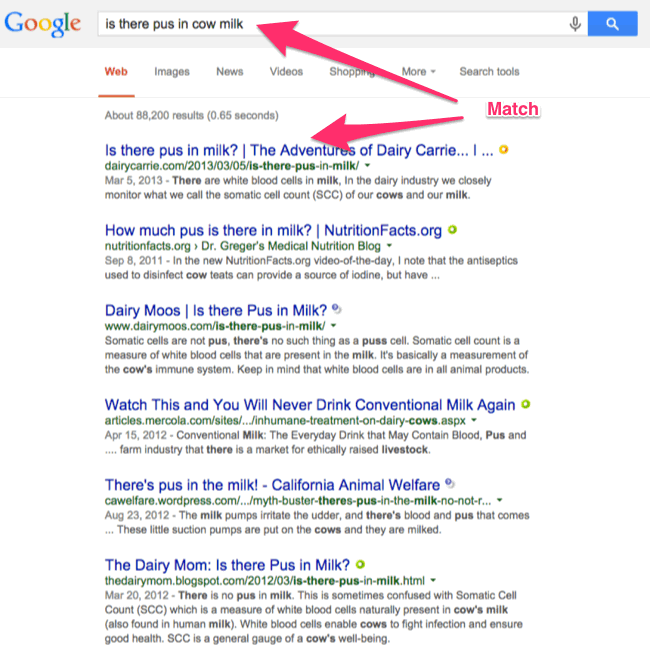
But that doesn’t mean that just because you wrote down what you know or maybe did a little video about it that Google will magically put you at the top of the topic you are taking about.
In fact, there are over 200 different factors that Google has in its algorithm to determine who makes it to the top of their search page called SERP (Search Engine Results Page).
So how do you know what topics you rank for right now?
You need Google Webmaster Tools installed on your website or blog.
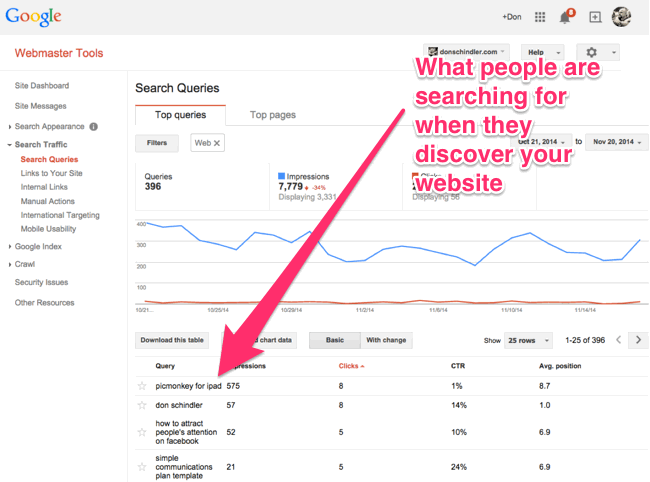
Once in Webmaster Tools, you can see a lot of information about your website – what you are ranking for, what impressions you have, what missing pages or broken links you have, etc… This tool is a must if you plan on understanding anything about your website and SEO. So go install it now and then come back. I’ll wait. Seriously.
Once you have your webmaster tools installed (you did it, right?). Don’t just cheat and keep reading. Let’s talk about SEO.
First, what is SEO?
Well, according to the guys at Moz who rock at SEO, they say that SEO or Search Engine Optimization “is the practice of improving and promoting a website in order to increase the number of visitors the site receives from search engines.”
I will try to simplify it by saying doing SEO is like learning the search engine language. You speak English or Spanish or whatever to the people around you and they understand what you are saying. You need to do the same thing for Google. SEO is Google’s language and the better you are at speaking to Google, the higher your chances are for showing up at the top of their SERP.
BTW, does it matter if you are on the first page of a search term?
A BIG FAT YES!
If you are on Page 2 then you might as well be non-existent. The first page means everything – very, very few people move past the first page.
The search query is a term within SEO you should be familiar with. This is what people type or speak into the search box.
Now search queries have changed over the years – it used to be that people only used a few words when typing into Google. But now, people speak or type entire sentences and they revise a lot when they aren’t getting the results they want.
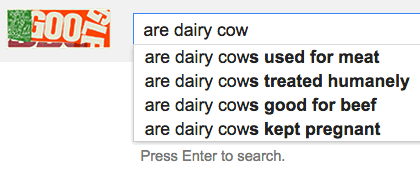
You may have noticed that Google uses Autocomplete to try and guess what people are looking for – and they are getting very smart and accurate about these search queries. They will present you a list of 3 or 4 options as you go along and try to lead you in your search pursuits.
Blogging tip – write blog posts based on other people’s search queries and you could find yourself getting more traffic.
So those websites that show up at the top of the search queries on SERPs, how do they get there? How is Google ranking these websites?
Well, there are a lot of factors and Google gives you a high level explanation of search on this website.
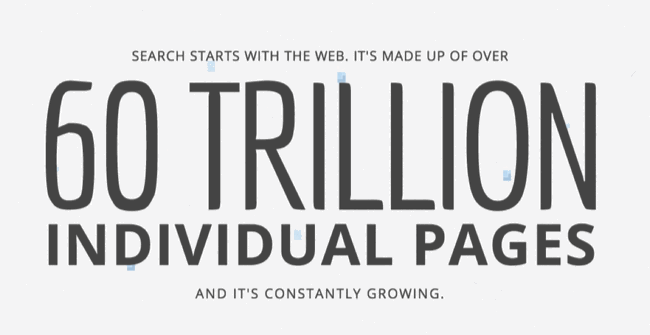
But I would say there are just a few things you should worry about.
Google loves relevancy and popularity combined with your location. Pretty simple, huh?
Actually, it’s a lot more complex and if you want to see how the SEO experts break it down, you can check out the Search Engine Ranking Factors from moz.org.
But here’s how I would define.
Relevancy – means how much you talk about your topic.
Popularity – means you have a lot of links to your website from outside sources that say you are a trusted source for this topic. It also means more likes and shares from popular social networks (Google+ is the highest so that can help you decide whether you need to be using that ghost town of a network) and the power of the pages that are linking to you.
With popularity, there are also negative things to consider and that might work against you. If you add lots of videos (not embedded from YouTube – those don’t count) and images on the page causing it to load slow that could be a problem. Or if you have links coming from websites that are known to be spam or maybe you have URLs with a lot of numbers and your URLs are very long. Google has issues with these things.
Location – the closer you are to the person searching, the better chance you have to coming up. This works really well for local shops and restaurants.
So this is a lot of stuff and you probably don’t have a lot of time to learn a lot of new stuff and do a lot of new stuff. It’s hard enough just coming up with new content so I’ve made a quick and dirty list of SEO things that you should know.
How to do SEO for yourself quickly.
1. Don’t DIY your website. – I know that a lot of people who like to have things look their way on their websites/blogs but you are better off to pick a popular well-used template and install that vs. hiring a graphic designer / coder who may not understand SEO very well.
They could set up your website with some bad SEO practices and then you’ll be hiding things from Google by accident.
2. Install Google Webmaster Tools on your website. – This will help you tremendously in determining how Google views your website. Yes, I’m repeating myself here – it’s that important.
3. Use Xena or Screaming Frog to check for broken links. – Even Google Webmaster Tools can help you find broken links. Once you find them, try and fix them.
4. If you are using wordpress (not wordpress.com or blogger/blogspot), you can use SEO by Yoast to help you fill in the necessary meta data. – Many websites I notice have the same meta data for each page of the website – meta data should be different for each page – that is an easy fix and benefits the website a lot.
5. Make sure you are spreading your blog posts across multiple networks as well as email if you have that. – Your post isn’t done when you hit Publish – it’s just starting. You need to actively push the post through your social networks to your audience. Some cool tools to help you do this are Buffer or Social Oompf.
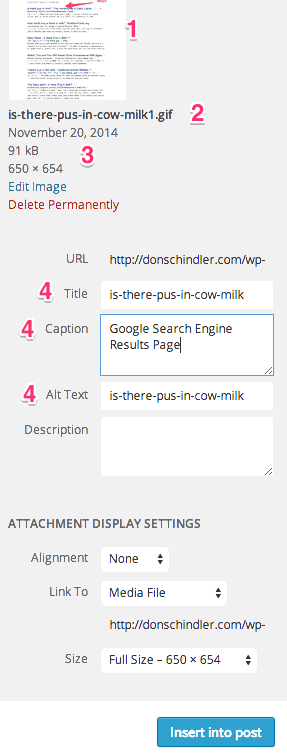
6. When adding images and video to your blog, make sure you are adding Alt. Text, Captions and Titles as well as naming the image and video with keywords of what it is. When I build a photo or image for my blog, here are the steps I follow.
- Make the photo/image.
- Label the photo using keywords with dashes. Like an image of our offices might be labeled dairy-management-inc-newsroom-2014.jpg
- Upload to my blog.
- Put in the meta data and the caption.
- Mark it as the featured image on the page (if necessary due to the template)
- Make sure when I share the blog post on social media that the image comes up as part of that post and not the other images on the page.
7. Guest blog on other websites and link back to yourself via your bio. – Guest blogging can sometimes be difficult to do because you have to have trusted relationships with those in charge of the blog you want to be a part of but trust me if you get the opportunity you should do it (but only on websites that are associated with the same topics as your website). Google is cracking down on guest blogging black hat techniques so be aware of that.
How do you begin guest blogging? Follow the blogs you want to be on and reach out. Simply Google things like “best farming blogs to follow”, “best food posts 2014”, “top agriculture blogs to follow”, etc… They will pop up.
8. Take some time and add your website to directories and lists. – Is your blog listed in any directories or lists? It should be. There are many places to add your blog and make sure it gets listed. You can also use tools to “ping” these directories to let them know you updated your post recently like Pingomatic.
9. Longer text is found more often than short posts. – People are scanning the internet still – but they want deeper content. Writing over 1000 words can seem like a lot but I’ll bet if you get going on a post, the words will just flow.
You should edit and keep people interested (adding images and video will do that) but a longer post will be seen as more relevant – that you put more time into it and has a better chance of being linked to and indexed by Google.
10. Quote the experts in the field you want people to find out about you. – If it’s about farming, there’s nothing wrong with quoting from other farmers, government, organizations, foodies, etc…
This marketing technique of calling out the most popular people on the internet has been going on forever but it still works. A lot of real celebrities will probably ignore you since they rely on other media to generate their popularity but internet famous people are usually right there to talk to and get information from. They are also usually very aware when someone talks about them online because they are using monitoring tools like Mention.com or Talkwalker.com/alerts. BTW, you should start using them too to monitor when people talk about you.
How do you measure this is working?
Google Webmaster Tools combined with Google Analytics will help you answer this question but that’s another post coming down the road.
What about you guys? Any fun tips for handling SEO on your blogs?
Leave a Reply